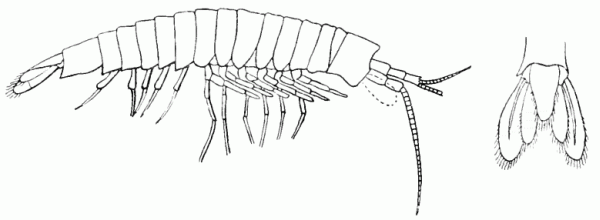
| Palaeos |  |
Malacostraca |
| Arthropoda | Syncarida |
| Page Back | Unit Up: Arthropoda | Unit Home | Clade Up: Eumalacostraca | Page Next |
| Unit Back: Ostracoda | Clade Down: None | Dendrogram | References | Unit Next: Decapoda |
|
Abbreviated Dendrogram
CRUSTACEA | `--MALACOSTRACA |--Phyllocarida `--+--Hoplocarida `--Eumalacostraca |--Syncarida | |--Anaspidacea | `--Bathynellacea |--Peracarida `--Eucarida `--DECAPODA |
Contents
Overview |
Taxa on This Page
The name Syncarida was applied by Packard to a group of Carboniferous and Permian Crustacea of obscure affinity. The discovery of living animals in South-East Australia shed new light on the subject, and reinvestigation of some of the fossils emphasised their close agreement with the Recent Anaspides and similar species .- Zittel & Eastman 1913
Species in the family Anaspididae vary from being strict stygobionts (only living underground) to species living in lakes, streams and moorland pools, and are found only in Tasmania. The family Koonungidae is found in Tasmania and the south-eastern part of the Australian mainland, where they live in the burrows made by crayfish and in caves. The families Psammaspididae and Stygocarididae are both restricted to caves, but Stygocarididae has a much wider distribution than the other families, with Parastygocaris having species in New Zealand and South America as well as Australia; two other genera in the family are endemic to South America, and one, Stygocarella, is endemic to New Zealand. - Wikipedia. The current geographic distribution indicates these are relics from an original pan-Gondwanan population. During the Carboniferous, these animals were common in freshwater envirnments in the northern continents. MAK120518
 Palaeocaris typus Meek and Worthen. Mazon Creek Lagerstätte (Westphalian D; Illinois), Moscovian age. Left, Restoration of body, omitting eyes, Right, Telson and uropods, Zittel & Eastman 1913. |
Of the fossil genera, Palaeocaris Meek and Worthen (Praeanaspides Woodward) (right) from the Late Carboniferous of England and North America, is now the most completely known. It resembles Anaspides in general form, in the segmentation of the body, the pedunculated (stalked) eyes, the characters of antennules, antennae, and even of the minute mouth-parts, the exopodites of the thoracic legs, and the form of the tail-fan. The only important difference, apart from the delicate lamellar gills which may not be preserved in a fossil, is the presence in Palaeocaris of a wedge-shaped first thoracic somite, which, in Anaspides, is fused with the head. Uronedes, from the Early Permian of Saarbrücken (in Saarland in Germany), resembles Palaeocaris but has one of the anterior pairs of legs enlarged and armed with spines. Acanthotelson Meek and Worthen, and Pleurocaris Caiman, from the Late Carboniferous of Illinois and of England respectively, have the first thoracic somite fused with the head and may perhaps have no thoracic exopodites. These exopodites are also stated to be absent in Gasocaris Fritsch, from the Earliest Permian Gaskohle of Bohemia - Zittel & Eastman 1913
Range: From the Carboniferous
Phylogeny: Eumalacostraca : Eucarida + Peracarida + * : Anaspidacea + Bathynellacea
Characters: no carapace, the first thoracic segment is fused with the head. Twenhofel & Shrock 1935
Range: From the Carboniferous
Phylogeny: Syncarida : Bathynellacea + *
Characters: Carapace absent. First thoracic somite fused with the head, or defined therefrom by a groove. Eyes pednncidate or sessile. Thoracic legs typically toith exopodites ; no oostegites. Uropods and telson forming a tail-fan. - Zittel & Eastman 1913
Comments: known from the Carboniferous and Permian. The only living represnetatives are a few Gondwanan fresh-water forms. Palaeocaris (Pennsylvanian) is representative of the fossil genera and Anaspis is the best known living genus. The carapace covers the cephalothorax and the eyes are stalked. - Twenhofel & Shrock 1935
Range: No fossil record
Phylogeny: Syncarida : Anaspidacea + *
Comments: Live interstitially in groundwater. Some species can tolerate low salt concentrations, and at least one African species is a thermophile, living in hot springs and tolerating temperatures up to 55 °CBathynellaceans are minute, blind, worm-like animals with short, weak legs, reaching a maximum size of 3.4 millimetres. They are found on every continent except Antarctica, although they are missing from some islands, including Fiji, New Caledonia and the Caribbean islands. There are two families, Bathynellidae and Parabathynellidae; a third family, "Leptobathynellidae", is considered a synonym of Parabathynellidae. - Wikipedia
| Page Back | Unit Home | Page Top | Page Next |
Page MAK120518 Creative Commons Attribution